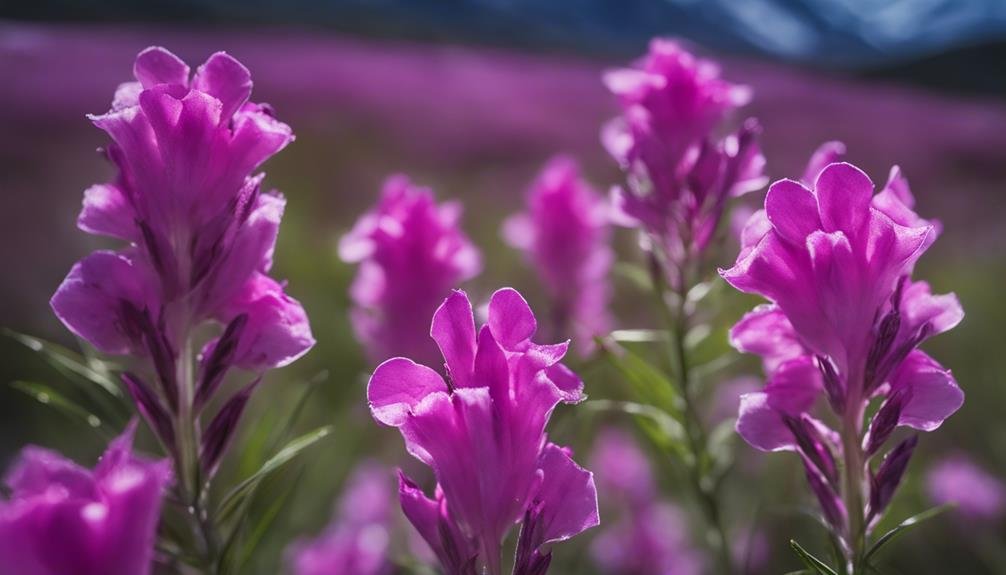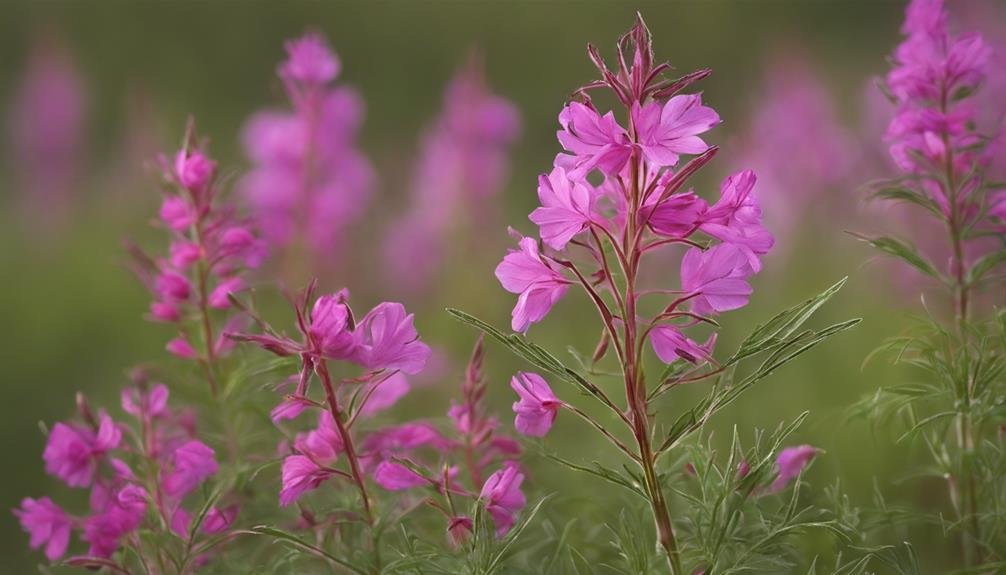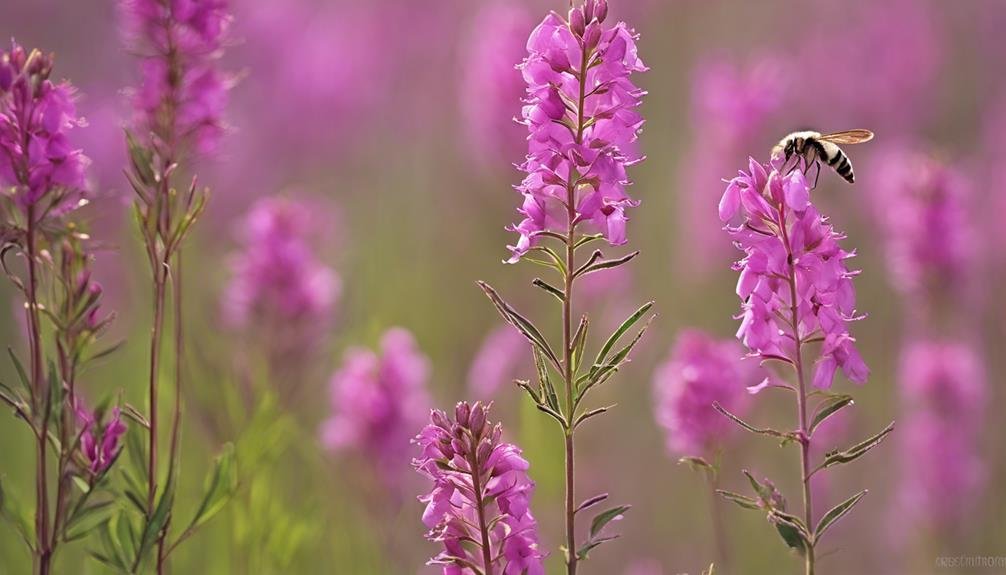What role does Willow Herb play in our ecosystems? This question invites an exploration into the nature and ecological significance of the Epilobium genus.
Willow Herb, known scientifically as Epilobium, is a notable component of many ecosystems across the globe. Its presence is marked by the distinctive rose-purple flowers that not only add a splash of color to the landscape but also serve an important function in attracting pollinators. This genus encompasses a variety of species that thrive in different environments, showcasing its adaptability and resilience.
The rapid growth and spread of Willow Herb can lead to discussions about its effects on native plant communities and whether its dominance poses a threat to biodiversity. Balancing the ecological benefits of Willow Herb with its potential to outcompete native flora is a challenge for ecologists and conservationists.
This overview sets the stage for a deeper investigation into how Willow Herb integrates with and impacts the ecosystems it inhabits, highlighting the fine line between its beauty and its capacity for dominance.
Key Takeaways
Key Takeaways:
- Epilobium is renowned for its distinctive rose-purple flowers that not only beautify ecosystems but also play a crucial role in attracting pollinators, thereby supporting biodiversity.
- The rapid growth and habitat domination by Epilobium species can threaten local flora, underscoring the need for effective management to protect indigenous plant life.
- Balancing the ecological contributions and potential challenges of Epilobium is vital for ensuring environmental sustainability through careful study and management practices.
Epilobium Overview
Epilobium’s Remarkable Diversity
The Epilobium genus is home to around 197 species, showcasing a wide range of growth forms from annual herbaceous plants to perennials, and sometimes even evolving into subshrubs. This incredible variety allows them to quickly cover large areas, highlighting their ability to become dominant players in various ecosystems. Their success in rapid spread is mainly due to an effective reproduction strategy, particularly through their seed dispersal capabilities. The seeds of Epilobium are designed with fine, hair-like structures, making them exceptionally skilled at wind transportation, which aids their spread across multiple habitats.
Adaptability and Ecological Impact
In places like Washington State, Epilobium has a significant presence, thriving across diverse environments. This adaptability to various soil and climate conditions is a testament to their resilience and widespread occurrence. Species within the Epilobium genus, such as Hairy Willowherb, Rock Fringe, and Fireweed, are pivotal in ecological roles. They’re often the pioneers in areas disturbed by events like fires, spearheading the ecological succession process. These plants aid in ecosystem recovery and promote biodiversity by attracting pollinators like bees.
The ecological versatility and importance of Epilobium highlight its value in understanding and preserving local and wider ecosystems.
Flower Characteristics

Delving into the Attributes of Willow Herb Flowers
Petals That Paint a Picture
Each Willow Herb flower boasts four petite petals, washed in a soft pink color that seems almost painted onto the natural canvas of their environment. This coloration not only adds a gentle splash of color but also highlights the flower’s delicate structure.
A Unique Edge
The distinctive notched edges of the petals lend the flowers a unique appearance, setting them apart from the myriad of other flora in their habitat. This characteristic contributes to the easily identifiable nature of the Willow Herb amidst the green tapestry of the landscape.
Season of Splendor
The flowering season, encapsulating the warm months of July and August, marks a period when the Willow Herb adorns its surroundings with vibrant hues. During this time, the plant becomes a focal point of color and life, drawing the gaze of passersby and the attention of pollinators alike.
Contributors to Biodiversity
Willow Herb flowers aren’t merely ornaments of nature; they serve a pivotal role in supporting the local ecosystem. By attracting pollinators like bees, these flowers are instrumental in the process of pollination, thereby aiding in the preservation and promotion of biodiversity within their locale.
Global Presence

Global Adaptability of Willow Herb
The Willow Herb genus, encompassing 197 species, is a testament to the remarkable adaptability of plants. With its ability to occupy diverse habitats, it showcases its versatility by thriving in subarctic, temperate, and subantarctic regions around the globe. This wide-ranging adaptability not only highlights the resilience of Willow Herb in facing cold climates but also its capability to flourish in various challenging environmental conditions.
Habitats and Climate Zones
The habitats Willow Herb occupies are as varied as the climate zones they fall under. From the cold, montane, and tundra regions of the subarctic to the moderate climates of temperate zones where it grows in forests and meadows. In the subantarctic, its resilience is again evident in montane and coastal areas. Remarkably, Willow Herb also finds a place in tropical regions, thriving in the cooler montane biomes. This ability to adapt to a wide range of climates and habitats underscores the ecological significance of the Willow Herb genus.
Ecological Impact and Biodiversity
In places like North America, Willow Herb’s presence is a boon for biodiversity, especially in the region’s cool montane biomes within subtropical and tropical areas. Its role in the ecosystem is varied, from supporting wildlife to maintaining ecological balance. As a herbaceous plant, Willow Herb exhibits a range of life cycles from annual to perennial, further contributing to its role in supporting diverse ecosystems. This versatility not only aids in the plant’s survival in different climates but also enhances the ecological balance of the regions it inhabits.
Through its widespread distribution and ecological contributions, Willow Herb exemplifies the incredible adaptability and ecological importance of plant species. Its presence in a variety of habitats from cold to warm climates across the globe showcases the resilience and versatility of plants in the face of environmental challenges.
Pollinator Attraction Mechanisms

In the realm of plant-pollinator interactions, the Willow Herb stands out for its adaptive strategies to ensure reproductive success. This plant, belonging to the genus Epilobium, has fine-tuned its approach to attracting pollinators, which is fundamental for its survival and the broader ecological balance. Let’s delve into the intricate ways through which Willow Herb captivates its pollinating allies.
Nourishment Through Nectar
One of the primary strategies employed by Willow Herb is the production of nectar. This sweet, energy-rich liquid serves as a magnet for pollinators like bees and butterflies, offering them sustenance. The nectar not only feeds these vital insects but also facilitates the plant’s reproductive process through the transfer of pollen.
Design of Floral Structures
Willow Herb exhibits a thoughtful design in its floral architecture to accommodate its pollinator guests. The structure of its flowers is specifically tailored to enable easy access for pollinators, thus improving the efficiency of pollen transfer. This feature ensures that pollinators can navigate the flowers effectively, aiding in the plant’s reproductive cycle.
Visual Appeal with Colorful Blooms
The vibrant pink flowers of the Willow Herb serve a dual purpose. Not only do they add a splash of color to the environment, but they also act as visual signals to bees and butterflies. These colorful cues are critical for attracting pollinators from afar, directing them to the source of nectar and pollen.
Fostering Genetic Diversity
The interaction between Willow Herb and its pollinators is a cornerstone for genetic variation within the plant population. Through the process of cross-pollination facilitated by different pollinators visiting the flowers, genetic diversity is promoted. This diversity is a key factor in the resilience and adaptability of the Willow Herb, allowing it to thrive in varied environments.
These strategies highlight the complex and mutually beneficial relationship between Willow Herb and its pollinators. The delicate balance of nectar production, floral structure design, visual attraction, and genetic diversification underscores the interconnectedness of plant and pollinator well-being, showcasing the critical role of pollinators in maintaining biodiversity and ecosystem health.
Habitat Loss Impact

Impact of Willow Herb on Ecosystems
The spread of Willow Herb poses a significant threat to diverse habitats, particularly wetlands. This invasive plant’s ability to quickly dominate landscapes impacts both the flora and fauna dependent on these critical environments.
Displacement of Native Plants
One of the primary issues with Willow Herb’s proliferation is its tendency to oust indigenous species. This aggressive growth strategy reduces the overall biodiversity of the area, as native plants struggle to compete for sunlight, nutrients, and space. The displacement leads to a less resilient ecosystem, vulnerable to further environmental stresses.
Obstruction of Waterways
The dense thickets formed by Willow Herb can significantly obstruct natural water flow. This blockage not only affects the quality of water but also poses a risk to aquatic life that relies on these waterways for habitat and food sources. The alteration in water flow can lead to changes in the wetland’s character and function, impacting its ability to support a diverse range of life.
Quick Habitat Takeover
The rapid colonization of Willow Herb, facilitated by its seed dispersion and rhizome growth, allows it to swiftly take over large areas. This rapid expansion reduces the available space and resources for native flora and fauna, leading to a decline in habitat quality. The speed at which Willow Herb can establish itself in new areas makes it particularly challenging to control and manage.
Control Strategies
Addressing the spread of Willow Herb requires targeted control measures. These strategies are designed to manage its growth and prevent further encroachment into native habitats. Effective control methods are vital to preserving the biodiversity and functionality of affected ecosystems.
Through a focused approach to managing Willow Herb, conservation efforts aim to protect and restore the balance within wetland ecosystems. Recognizing the significant impact of this invasive species is the first step in mitigating its effects and ensuring the health of diverse habitats.
Frequently Asked Questions
What Does Willow Herb Do?
Q: What is the primary use of Willow Herb?
A: Willow herb is primarily used for herbal applications geared towards health issues and skin soothing. It contains rich nutrients and plays a vital role in supporting ecosystems by offering food to bees and other pollinators.
Should I Remove Willowherb?
Q: Should I remove willowherb from my garden?
A: Yes, removing willowherb is beneficial for your garden. It helps improve the aesthetics of your garden, promotes soil health, and is an effective weed control strategy. Removing it also protects native plants from being displaced. However, it’s important to have a detailed management and eradication plan for best results.
What Are the Benefits of Epilobium?
What are the key benefits of using Epilobium?
Q: What makes Epilobium beneficial for health?
A: Epilobium is known for its significant health benefits. It offers the advantages of herbal tea, has potent antioxidant properties, and aids in skin improvement. The leaves and stems are nutrient-rich, making it a sought-after option for those pursuing natural health solutions.
Is Willow Herb Safe?
Is Willow Herb Safe to Use?
Q: Can I safely use Willow Herb?
A: The safety of Willow Herb is not fully established due to a lack of toxicity data, the potential for interactions with other herbs, risks of skin sensitivity, and challenges in cultivation. Caution is advised until further research is conducted.
Are Arctic Willow and Willow Herb Related or Have Similar Uses?
Arctic willow and willow herb belong to the same botanical family but serve distinct purposes. The arctic willow withstands harsh, cold climates, providing erosion control and sustenance to wildlife. Willow herb thrives in different environments and is often used medicinally. Explore more about their roles with arctic willow plant facts.
Do Dwarf Birch and Willow Herb Grow in Similar Habitats?
Dwarf birch and willow herb are commonly found in cold, northern climates, such as tundra regions. Both species thrive in nutrient-poor soils, often near wetlands or open spaces. For a more detailed insight into the characteristics and adaptations of one species, explore a comprehensive dwarf birch overview to learn more.
Conclusion
To summarize, Epilobium stands out for its widespread presence and the role it plays in multiple ecosystems with its eye-catching rose-purple flowers. These flowers aren’t only a visual treat but also serve a vital function in attracting numerous pollinators, thus supporting local biodiversity.
Despite its benefits, the genus’s ability to grow quickly and dominate habitats poses a risk to indigenous plant species. This dual nature highlights the significance of implementing balanced management strategies.
It’s imperative to acknowledge both the ecological and aesthetic contributions of Epilobium while addressing the challenges it presents. Proper analysis and thoughtful consideration of its characteristics and impacts are key to ensuring environmental sustainability.


